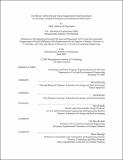| dc.contributor.advisor | Howard Herzog. | en_US |
| dc.contributor.author | De Figueiredo, Mark A. (Mark Anthony), 1978- | en_US |
| dc.contributor.other | Massachusetts Institute of Technology. Dept. of Civil and Environmental Engineering. | en_US |
| dc.coverage.spatial | n-us-hi | en_US |
| dc.date.accessioned | 2005-05-19T15:19:49Z | |
| dc.date.available | 2005-05-19T15:19:49Z | |
| dc.date.copyright | 2003 | en_US |
| dc.date.issued | 2003 | en_US |
| dc.identifier.uri | http://hdl.handle.net/1721.1/16929 | |
| dc.description | Thesis (S.M.)--Massachusetts Institute of Technology, Engineering Systems Division, Technology and Policy Program; and, (S.M.)--Massachusetts Institute of Technology, Dept. of Civil and Environmental Engineering, 2003. | en_US |
| dc.description | Includes bibliographical references. | en_US |
| dc.description | This electronic version was submitted by the student author. The certified thesis is available in the Institute Archives and Special Collections. | en_US |
| dc.description.abstract | In December 1997, an international project agreement was signed in Kyoto for a collaborative study of the direct injection of carbon dioxide into the deep ocean. After a detailed international site selection process, the Natural Energy Laboratory of Hawaii Authority (NELHA), a quasi-governmental organization, was chosen as the host for the project in March 1998. In addition to fulfilling the necessary technical criteria, NELHA maintained an ocean research corridor, and it was impressed upon the project team that this could facilitate the permitting process. International steering and technical committees served as advisors to the Hawaii-based project general contractor, Pacific International Center for High Technology Research. The committees also planned a multi-year public outreach program to engage residents of Hawaii about the carbon sequestration project. Before the outreach program began, a reporter wrote about the planned carbon sequestration experiment in a March 18, 1999 front-page article in the local newspaper, West Hawaii Today. As a result, some members of the community started organizing an opposition to the project, culminating in the creation of the "Coalition Against CO2 Dumping." Concerns raised by the opposition included the environmental impacts on the ocean ecology, Not-In-My-Backyard feelings, anti-fossil fuel sentiment, and issues regarding native Hawaiian sovereignty. The project team reacted by implementing a dual public relations and outreach strategy, creating a website, responding to hundreds of emails and letters, and holding public meetings. A major fallout from the opposition was that permitting became much more difficult, involving multiple agencies on the state and federal level. In addition, the controversy affected the project's relationship to its NELHA host and caught the attention of the Hawaii state legislature. After the project team conducted an Environmental Assessment, US Department of Energy issued a Finding of No Significant Impact (FONSI), an important milestone in the permitting process. This thesis summarizes the events from project start through the issuing of the FONSI, discusses the lessons learned from the experience, and provides recommendations for institutions dealing with public perception issues in future projects. | en_US |
| dc.description.statementofresponsibility | by Mark Anthony de Figueiredo. | en_US |
| dc.format.extent | 239 p. | en_US |
| dc.format.extent | 1298766 bytes | |
| dc.format.extent | 1298521 bytes | |
| dc.format.mimetype | application/pdf | |
| dc.format.mimetype | application/pdf | |
| dc.language.iso | eng | en_US |
| dc.publisher | Massachusetts Institute of Technology | en_US |
| dc.rights | M.I.T. theses are protected by copyright. They may be viewed from this source for any purpose, but reproduction or distribution in any format is prohibited without written permission. See provided URL for inquiries about permission. | en_US |
| dc.rights.uri | http://dspace.mit.edu/handle/1721.1/7582 | |
| dc.subject | Technology and Policy Program. | en_US |
| dc.subject | Civil and Environmental Engineering. | en_US |
| dc.title | The Hawaii carbon dioxide ocean sequestration field experiment : a case study in public perceptions and institutional effectiveness | en_US |
| dc.type | Thesis | en_US |
| dc.description.degree | S.M. | en_US |
| dc.contributor.department | Massachusetts Institute of Technology. Department of Civil and Environmental Engineering | |
| dc.contributor.department | Massachusetts Institute of Technology. Engineering Systems Division | |
| dc.contributor.department | Technology and Policy Program | |
| dc.identifier.oclc | 53067186 | en_US |
